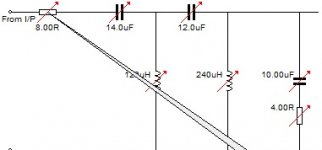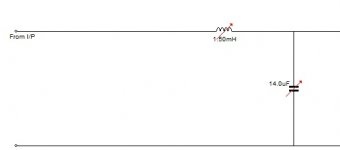I had designed a custom crossover for my sound box of single 12in speaker and a 2in tweeter.
When the sound is playing at low levels it is sounding perfectly balanced, when i increase the levels of the music played the mid high balance is completely lost.
What should i do to maintain the tonal balance even at high levels.
It is a 12db network for the speaker and a 24db network for the tweeter.
When the sound is playing at low levels it is sounding perfectly balanced, when i increase the levels of the music played the mid high balance is completely lost.
What should i do to maintain the tonal balance even at high levels.
It is a 12db network for the speaker and a 24db network for the tweeter.
Something's probably distorting and/or running into power compression. Is there too much treble or not enough?
3 things.
Human hearing changes depending upon sound levels, we are much less sensitive to very low and very high frequencies at low SPLs and that relationship flattens some at higher SPLs.
Speaker parameters at high power levels are different than small signal parameters you see published, so the crossover really needs to be designed for the target power level.
Some types of amplifiers can significantly alter tonal balance when pushed towards their design limits, the most significant of those being tube amps and very cheap solid state amps. You also get the same effect when pushing a signal into compression or into a limiter.
Human hearing changes depending upon sound levels, we are much less sensitive to very low and very high frequencies at low SPLs and that relationship flattens some at higher SPLs.
Speaker parameters at high power levels are different than small signal parameters you see published, so the crossover really needs to be designed for the target power level.
Some types of amplifiers can significantly alter tonal balance when pushed towards their design limits, the most significant of those being tube amps and very cheap solid state amps. You also get the same effect when pushing a signal into compression or into a limiter.
Last edited:
3 things.
Human hearing changes depending upon sound levels, we are much less sensitive to very low and very high frequencies at low SPLs and that relationship flattens some at higher SPLs.
Speaker parameters at high power levels are different than small signal parameters you see published, so the crossover really needs to be designed for the target power level. - How do you recommend we design the crossover for high power levels. The frequency response readings taken for speakers and tweeters are at low signal levels.
Some types of amplifiers can significantly alter tonal balance when pushed towards their design limits, the most significant of those being tube amps and very cheap solid state amps. You also get the same effect when pushing a signal into compression or into a limiter.
Something's probably distorting and/or running into power compression. Is there too much treble or not enough?
The treble gets dominating and too sharp for ears st high levels
When we push the signal levels from the amplifier at high SPL levels the system is not able to maintain the same tonal balance and the tonal texture at high SPL levels
The drivers themselves can also exhibit power compression, mostly due to the non-linearity of the motors at high excursions. Tweeters as well as woofers can do this. It's the main reason many speakers "blare" at high volumes. The non-linearities produce more and more 2nd and 3rd order harmonics as the drivers are pushed harder and harder, and make the music sound worse and worse. It may have little to do with the crossover.
Last edited:
What are the details on this system? What drivers and amplifiers? What crossover is being used? Does it have a protection lamp in the high freq section?
I built a 15" +2" throat top over two dual 15" subs.
The 15" driver in the top is rated at 600W program material, but goes into severe power compression much over about 200W. The HF and subs are capable of at least 8dB~10dB more output.
It's easy to have the mids compress, while the HF and subs keep on going.
A new 4x 12" semi-horn design (Tony Wilkes) is in the works, it will handle 6dB more power, and be 7dB more efficient.

The 15" driver in the top is rated at 600W program material, but goes into severe power compression much over about 200W. The HF and subs are capable of at least 8dB~10dB more output.
It's easy to have the mids compress, while the HF and subs keep on going.
A new 4x 12" semi-horn design (Tony Wilkes) is in the works, it will handle 6dB more power, and be 7dB more efficient.

Last edited:
Is that a DIY project? Are there plans for that 4 X 12" would be nice to put a BMS 4592 on top? Thanks!
The treble gets dominating and too sharp for ears st high levels
Probably upper midrange. When a woofer starts compressing due to heat it loses LF output first. The tweeter may also be compressing, and you end up with a peak just below the crossover frequency. If using a passive crossover, the impedance changes in the driver will detune the crossover and make it even worse. To mitigate the effects, cross the LF to the horn low (which is why I like 2" HF units) and bi-amp if possible. You may want/need to balance (EQ) your system for the way it will sound when driven hard, not necessarily flat at small signal. You may also want to tune your box around 'hot' T/S parameters - that is, tune for a higher Qes.
Does the xover use iron-ore coils that could get saturated at higher SPL levels? You nee to scope the system to see where the problem is. E
"Is that a DIY project? Are there plans for that 4 X 12" would be nice to put a BMS 4592 on top? Thanks! "
Tony died last summer, he used all BMS drivers in the cabinet shown (he was the BMS rep in the UK).
There may be plans for this at SpeakerPlans.com, that's where this photo came from.
Tony died last summer, he used all BMS drivers in the cabinet shown (he was the BMS rep in the UK).
There may be plans for this at SpeakerPlans.com, that's where this photo came from.
What are the details on this system? What drivers and amplifiers? What crossover is being used? Does it have a protection lamp in the high freq section?
There is no projection lamp used in the crossover.
The drivers used are B&C 32MH and the highs used are B&C DE750
Amplifier used is Electrovoice Q44
The coil used for LF is of Ferrite Core.Does the xover use iron-ore coils that could get saturated at higher SPL levels? You nee to scope the system to see where the problem is. E
For HF they are of air core.
There is no projection lamp used in the crossover.
The drivers used are B&C 32MH and the highs used are B&C DE750
Amplifier used is Electrovoice Q44
OK, you have a 6 to 7dB difference in sensitivity between the woofer and tweeter, what are you using to balance that?
I have the DE750 with a pair of 15" drivers and the speakers maintain very good balance up to power levels well beyond what you have but my system is actively powered and processed.
That LF driver's got some peaking around 2-3k, at least according to the FR plot on the website. If the inductor is sarurating this peaking may come through. Depends where the nastiness is. If this peaking is from cone breakup it could certainly get worse ar high power levels. If the nastiness is above 3KHz then both of these theories are out the window.
Last edited:
OK, you have a 6 to 7dB difference in sensitivity between the woofer and tweeter, what are you using to balance that?
I have the DE750 with a pair of 15" drivers and the speakers maintain very good balance up to power levels well beyond what you have but my system is actively powered and processed.
I am using a attenuator in the input side of the highs circuit to suppress the diffrence of the highs and the mids.
Even Attached the circuit for your reference
Attachments
- Status
- Not open for further replies.
- Home
- Live Sound
- PA Systems
- Discolouration of sound at high levels

